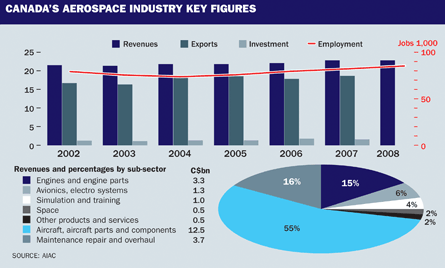Status quo might as well be an expletive in the lexicon of the diverse Canadian aerospace industry, where government and the civil aviation industry have recently taken a hard, honest look at an all but certain future.
"Without increased investment in research and development, the Canadian industry stands to lose its position in the world market," conclude the authors of a newly released technology roadmap by the government and industry, crafted because of concerns about the longevity of the economic engine that generates $23 billion annually to the nation's economy and employs more than 82,000 people, writes John Croft.
Flight International canvassed the key aerospace centres of Canada for this special report, learning more about the unique challenges and opportunities for growth faced by the world's fourth-largest aerospace producer by revenue, after the USA, France and the UK, and why a holistic retooling of the industry in response to civilian "green" mandates and military industrial needs is key to its long-term viability.
In the short term, a host of government initiatives are helping many companies survive until the aerospace industry fully recovers from the current downturn, a hurdle officials expect to be over by 2014 at latest.
 |
|---|
© Bilderbuch/Design Pics Inc/Rex Features |
Five years from now coincidentally is also the timeframe in which Canada should also begin to see the fruits of its new labour - the Canadian aerospace environmental technology roadmap. Chaired by Bombardier and shaped by the National Research Council (NRC), this took a year to produce and is designed to create "pre-competitive" enabling technologies that will allow the industry to better compete globally as environmental demands reshape the aerospace sector in the next five to 10 years.
Targeted technologies include engine emissions, aircraft noise, aircraft fuels and lifecycle impact, the consideration of manufacturing, maintenance, repair, overhaul and disposal. Signatories to the technology roadmap include Bell Helicopter Canada, Bombardier, Messier-Dowty, the NRC, Pratt & Whitney Canada, Rolls-Royce Canada and Transport Canada.
Captured under the CAETRM umbrella are several other key Canadian programmes - including GARDN and Future Major Platforms (FMP) - designed to showcase the country's technical prowess in the four targeted areas, but also to help create Canadian Tier 1 (systems integrator) companies where there were none before.
ENVIRONMENTAL TECHNOLOGIES
GARDN, the Green Aviation Research and Development Network, is a new grouping of 18 government, academic and industrial partners that are developing aviation environmental technologies with a budget of C$23 million ($20.8 million) over four years, split equally between industry and government. FMP, launched in June 2008, aims to position Canadian companies for work on five future platforms - next-generation single-aisle commercial aircraft to be built by Airbus and Boeing, Embraer business jets, the Airbus A350 and the Bombardier CSeries small airliners.
Urgency in the matter is being driven by the confluence of several trends, particularly in Europe where investment in research and development in green aviation initiatives, headed by the Clean Sky joint initiative, is nearly 2% of the continent's annual aerospace sales, or €1.7 billion ($2.41 billion), compared with 0.1% of Canada's yearly C$23 billion for the GARDN programme. Canada considers itself between Europe and the USA in terms of progress on environmental initiatives.
"This considerable discrepancy highlights the relative importance that has been placed on environmental initiatives in this innovation- and technology-intensive industry in Canada versus Europe," the authors of the technology roadmap say.
 |
|---|
© Alan Marsh/Design Pics Inc/Rex Features |
Also hindering Canada is its lack of Tier 1 suppliers that can manage and integrate the products of country's many Tier 2 and Tier 3 suppliers. That, combined with the fact that Canada relies on traditional machining, metal fabrication and assembly technologies, core competencies whose use is expected to "substantially" diminish in the new generation of aircraft, explains why suppliers are winning progressively "smaller portions of large international projects", officials say.
"This will be a major problem in a few years," says Claude Lajeunesse, president and chief executive of the Aerospace Industries Association of Canada (AIAC), of the lack of Tier 1 integrators. Lajeunesse says crucial to the new roadmap initiative is to create integrators through collaborative research and development efforts that are co-ordinated among suppliers and flow down from original equipment manufacturer requirements. He expects Tier 1 companies to be created either through mergers or from existing companies "growing a bit more rapidly".
Jerzy Komorowski, director general of the NRC's Institute for Aerospace Research, says that NRC's role is to work with OEMs to engage and develop technologies that end up in the hands of smaller companies. "The other role we have chosen for ourselves is to try and help the Canadian supply chain - smaller and medium-sized companies - to expand their technology portfolios and processes so they can be more attractive partners to industry."
Given the economy, there is always the risk that the nation's blue-sky thinking exercise that led to the technology roadmap could end up an under-funded pie-in-the-sky endeavour. An official with Bell Helicopter Canada says the company was a key player in the creation of GARDN, but is not currently part of the programme due to financial constraints. Lajeunesse says GARDN is adequately funded, however, with "plenty of companies" willing to put in the initial investment.
 |
|---|
Federal, provincial and local economic help will play a role in the new endeavour, as it has in the past. Companies say the federal government's strategic aerospace and defence international (SADI) programme, launched in 2008 as an evolution of Technology Partnerships Canada (TPC), "levels the playing field" with respect to indigenous aid that competitors also receive, and organisations such as Invest Quebec provide provincial help.
Examples include Bell Helicopter Canada, which plays a major role in designing, certificating and assembling Bell's civil rotorcraft line. The company developed its modular affordable product line concept, first employed on the new Bell 429 medium twin, in part with a 12-year loan of C$230 million split 50/50 between TPC and Invest Quebec.
At Pratt & Whitney Canada, which makes turbine engines in the 0-10,000lb thrust range (0-45kN) for its US-based parent Pratt & Whitney, a government loan through SADI represents 23% of a C$1.5 billion five-year research and development programme now under way.
INDUSTRY LOANS
CAE, developer and builder of simulation systems, has a C$250 million SADI loan as part of its C$714 million, five-year Project Falcon programme that includes simulator technology as well as an "augmented visionics" system that the company says will help pilots taxi, take off and land safely during restricted visibility situations.
Avionics maker CMC also has a SADI loan for C$52.3 million as part of its C$150 million "FrontTier" project. The five-year effort is designed to expand the company's "understanding of cockpit integration" and is product-oriented, according to CMC officials.
Other indirect aid from the government comes from the Export Development Corporation, which in the case of aircraft manufacturer Viking is making loans to customers for the first four or five new Viking 400 twin-engined turboprops coming off the line, and for simulator manufacturer Mechtronix works with Canadian banks to provide the confidence needed to make loans to customers in far-flung regions of the world.
Invest Quebec, which injects billion in funding into regional markets including Montreal, the world's largest aerospace hub after Toulouse and Seattle, could soon change the rules of play for provincial loans. Jacques Daoust, the organisation's chairman and chief executive, says it is beginning to create loans for aerospace linked to the eventual success of a product rather than a fixed interest rate, a process already in place for other sectors.
Under such a programme, a company would pay no interest for five or 10 years as a product is developed, but would ultimately pay back Invest Quebec with a percentage of the sales revenue on the product once it goes to market.
Without a renewed, holistic top-to-bottom refocusing and increased research and development dollars in the sector, however, success will be elusive, leaving Canada's glory days in the past. "Reserves of innovative technologies developed in the 1960s and 1970s that fed the dramatic growth of the Canadian aerospace sector in the 1980s and 1990s are now substantially depleted", say the authors of the technology roadmap."
Source: Flight International























